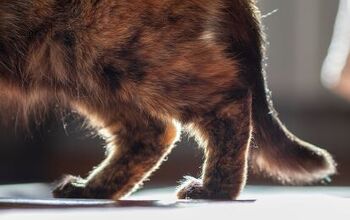What Is Megaesophagus in Cats?

Megaesophagus, or enlargement of the esophagus, is a condition that inhibits the ability of the esophagus to move food down into the stomach. Check out the information below to learn about this disorder, including its causes, symptoms, and treatments.
Causes of Megaesophagus in Cats
Kittens can be born with megaesophagus, or a cat may develop it later on. Experts aren’t entirely sure about what causes congenital megaesophagus. When acquired later on, megaesophagus may be the result of inflammation or a foreign body or tumor in the esophagus. Other causes might include parasitic infections, hormonal disease, neuromuscular diseases, or exposure to toxins like heavy metals.
Related: 5 Fascinating Facts About Cat Whiskers
Symptoms of Megaesophagus in Cats
Several symptoms can indicate that megaesophagus is present, but these can also be associated with other health conditions, so it’s important to have your kitten or cat examined by a veterinarian if these symptoms arise:
- Regurgitation
- Weight loss
- Gagging
- Poor or stunted growth
- Excessive salivation or drooling
- Bad breath
Keeping an eye out for signs of aspiration pneumonia, such as difficulty breathing, nasal discharge, coughing, difficulty swallowing, respiratory sounds, weakness, lethargy, and fever, is also important so that veterinary treatment can be provided promptly.
Related: Vomiting in Cats: When to Worry
Treatments for Megaesophagus in Cats
After your veterinarian diagnoses your pet with megaesophagus, he or she will try to pinpoint the cause so that it can be treated. Surgery might be recommended in certain cases. Medications might also be prescribed.
Ensuring your cat receives adequate nutrition through a high-calorie diet will be important, so your vet might recommend foods that are easy for your pet to ingest, such as slurries and liquid gruel, and you might need to feed smaller meals more frequently throughout the day. The goal will be to manage the symptoms and prevent regurgitation so that food can make its way into the digestive tract. In the event that your cat isn’t able to eat, a feeding tube might be used.
In order to avoid aspiration pneumonia (when food is accidentally inhaled into the lungs), your veterinarian will instruct you on the best way to position your pet’s body for feeding. Generally, maintaining an upright position that’s 45° to 90° from the floor is necessary, so you’ll need to set your pet’s food and water bowls at an appropriate angle to ensure the food makes its way down the esophagus. As an example, you might need to ensure your kitty eats from elevated bowls that make her stand on her hind legs so that gravity can help move the food into the stomach. There are products, such as specially designed feeding stations, that can help keep your pet at the correct angle. Then, after eating or drinking, you may need to hold your cat in an upright position for up to 15 minutes.
See the Vet Regularly
If your cat has been diagnosed with megaesophagus, seeing the vet regularly for checkups is recommended to ensure proper treatment protocols are followed. For some kitties, prognosis is poor, and some don’t survive because of complications caused by the disorder. For others, the condition might improve over time. Therefore, working closely with a veterinarian is necessary to help increase the odds of success.

Lisa Selvaggio is a freelance writer and editor, and our resident cats-pert, with certifications in pet nutrition and pet first aid. She enjoys producing content that helps people understand animals better so they can give their pets a safe and happy home.
More by Lisa Selvaggio























